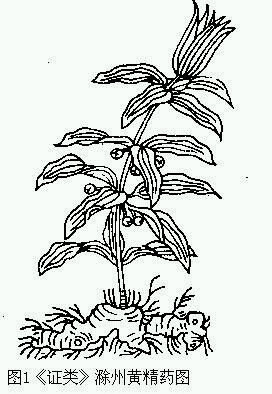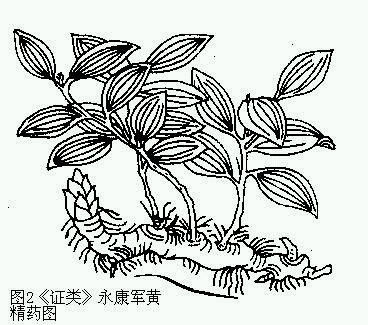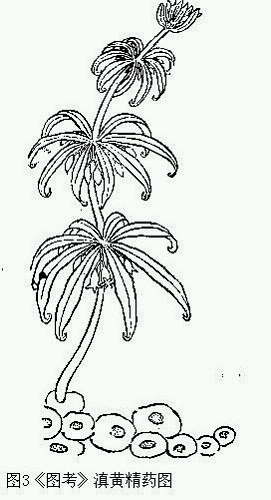| title | Solomonseal Rhizome |
| release time | 2006/8/31 |
| source | Jade Knock Studio |
Currently, Solomonseal Rhizome is the dried rhizome of Polygonatum kingianum Coll. et Hemsl., Polygonatum sibiricum Red., or Polygonatum cyrtonema Hua, which belong to the Lily Bulb family. In the market, Solomonseal Rhizome is commonly referred to as "Rhubarb Rhizoma essence," "Chicken Head Solomonseal Rhizome," or "Ginger-shaped Solomonseal Rhizome" based on its shape. The majority of Solomonseal Rhizome in the market is Polygonatum sibiricum, followed by Polygonatum kingianum and Polygonatum cyrtonema, with occasional admixtures of other species from the same genus. Polygonatum kingianum is mainly produced in Luodian, Xingyi, Zhenfeng, and Xingling in Guizhou; Jingxi, Debao, Longlin, and Leye in Guangxi; and Qujing and Dayao in Yunnan, primarily for local consumption. Polygonatum sibiricum is mainly produced in Zunhua, Qian'an, and Chengde in Hebei; Wuchuan, Zhuozhi, Liangcheng, and Baotou in Inner Mongolia; and also in Henan, Shaanxi, Shandong, Shanxi, Liaoning, Jilin, and Heilongjiang provinces, with Hebei and Inner Mongolia being the largest producers. Polygonatum cyrtonema is mainly produced in Zunyi, Bijie, and Anshun in Guizhou; Anhua, Yuanling, and Qianyang in Hunan; Neijiang in Sichuan; Huanggang and Xiaogan in Hubei; Wuhu and Lu'an in Anhui; Ruian and Pingyang in Zhejiang; and Yunnan, with Guangxi, Guangdong, and Fujian also producing it. Guizhou and Hunan are known for their high yield and superior quality.
Materia medica research suggests that ancient Solomonseal Rhizome mainly originated from the Polygonatum genus of the Lily Bulb family, with Polygonatum sibiricum being the mainstream medicinal source. Solomonseal Rhizome does not have a distinct regional specificity, but historically, Jiangsu, Henan, and Zhejiang have been recorded as long-standing producers of Solomonseal Rhizome.
bubble_chart Varietal ExaminationTaoists regard Solomonseal Rhizome as an immortal herb. The *Bowuzhi* refers to it as "the grass of Taiyang (EX-HN5)," claiming that consuming it can lead to immortality. The *Baopuzi Neipian: Xianyao* states: "Solomonseal Rhizome is also known as Tu Zhu, Jiu Qiong, and Chui Zhu. Consuming its flowers is superior to consuming its fruits, and consuming its fruits is superior to consuming its roots, but the flowers are difficult to obtain in large quantities. Ten hu of fresh flowers yield only five to six dou when dried, and one can consume three ge per day. Only those with great strength and resources can manage this. Consuming Solomonseal Rhizome for ten years can yield significant benefits." Tao Hongjing noted: "Common folk remedies do not use this, but it is highly valued in the *Xianjing*. Its roots, leaves, flowers, and fruits can all be consumed, either in wine or powder form, as detailed in fasting prescriptions." According to the *Ishinpō*, Volume 26, citing the *Taiqingjing*: "Harvest Solomonseal Rhizome, preferably on the second day of the eighth month. Dig it up in the mountains and eat it raw, drinking water when thirsty. Extract three sheng of juice from fresh Solomonseal Rhizome, boil it until it forms a paste, and shape it into egg-sized pills. Consume one pill twice a day for twenty days, and you will no longer feel hunger." This likely represents a fasting method from the *Xianjing*. Additionally, the early Taoist text *Taishang Lingbao Wufu Xu*, Volume 2, states: "The celestial officials named this herb 'Wuji Zhi.' In the past, some people reached the inner city of Mount Huo and saw thousands of households cultivating this herb, some with dozens of hectares, others with dozens of mu. The roots and stems were exceptionally large, likely due to careful cultivation, unlike those growing wild in the mountains. It is also found in marshes. The people of the inner city were asked why they cultivated this herb, and they replied, 'This is an immortal herb; we have always consumed it to achieve longevity.' During the time of Sun Quan, the ruler of Wu, upon hearing this, he ordered people to cultivate and consume it in the mountains of Jiangdong. However, Sun Quan did not abstain from worldly desires, and thus could not reap its benefits. At that time, officials and soldiers were assigned to guard the cultivation sites. After the fall of Wu, the area was still known as Wanzhu Li or Huang Li, remnants of Sun Quan's cultivation efforts." Although this contains elements of legend, it confirms that Solomonseal Rhizome was cultivated in the Jiangnan region long ago.
The Dian Solomonseal Rhizome is mentioned in Volume 10 of Tukao. Wu Qijun states: "The Dian Solomonseal Rhizome has roots similar to those produced in Hunan but larger, weighing several jin, commonly used to stew meat, tasting like mountain yam. The stem is thick and purple, with six or seven leaves clustered in layers, initially all embracing upwards. At the peanut leaf margin, they hang down on all sides like tassels, greenish-white in color, turning reddish-yellow when old." According to its illustration (Figure 3), it is the Lily Bulb family plant Dian Solomonseal Rhizome Polygonatum kingianum.



Regarding ancient varieties of Solomonseal Rhizome, there are additional points to note. Many texts mention that Solomonseal Rhizome leaves resemble those of Gelsemium elegans, such as in Jizhu: "The leaves of Solomonseal Rhizome are similar to those of Gelsemium elegans, differing only in that the stem is not purple and the flowers are not yellow, which often confuses people. Their types are distinct, leading to life-and-death consequences, which is quite remarkable." Leigong Paozhi Lun states: "When using, avoid Gelsemium elegans, which truly resembles Solomonseal Rhizome, except for having two hairy hooks on the leaves, which is the distinguishing feature. Mistaken ingestion can be harmful. Solomonseal Rhizome leaves resemble Bamboo Leaf." Tujing states: "People in Jiangnan say: The seedlings and leaves of Solomonseal Rhizome somewhat resemble Gelsemium elegans, but Gelsemium elegans leaves are extremely pointed at the tip and the roots are thin." These references all originate from Zhang Hua's Bowuzhi, Volume 5: "Huangdi asked Tianlao: Are there any plants born of heaven and earth that can make one immortal upon eating? Tianlao replied: The grass of Taiyang (EX-HN5) is called Solomonseal Rhizome, consuming it can lead to longevity. taiyin The grass called Gelsemium elegans cannot be eaten, as it causes instant death upon ingestion." This Gelsemium elegans is not the Loganiaceae plant Gelsemium elegans (Garch.et Champ.) Benth. as known today, but possibly the Stemonaceae plant Croomia japonica Miq.
Regarding the cultivation of Solomonseal Rhizome, besides the previously cited Taishang Lingbao Wufu Xu, Nongzheng Quanshu Volume 40 cites Sishileiyao on its planting method: "In February, select those with opposite leaves, which are true Solomonseal Rhizome, break into pieces about two inches long, plant sparsely, and they will become very dense after one year. Seeds can also be used. The leaves are very beautiful, used in cooking, and the roots are suitable for decoction. Both Atractylodes and Solomonseal Rhizome are highly valued by Taoist immortals."
bubble_chart Historical Evolution of Authentic Production Areas
Solomonseal Rhizome was first recorded in Bielu, but Bielu did not mention its place of origin. Tao Hong-jing stated that "it is now found everywhere." The "Zhenglei" illustrated Solomonseal Rhizome from Chuzhou, Danzhou, Shangzhou, Xiezhou, Xiangzhou, Yanzhou, Hongzhou, Jingmen Army, and Yongkang Army, spanning both the north and south. Su Song mentioned, "It is now found in both the north and south, with those from Songshan and Maoshan being of good quality." More recently, the "Drug Production Identification" stated that "those produced in Hunan are genuine," while the "Medicinal Trade Regulations" of the Xi'an City National Medicine Commercial Guild in 1940 stated, "It is a wild perennial grass found everywhere." Both "Chinese Genuine Regional Materia Medica" and "Chinese Medicinals Commodity Science" list Solomonseal Rhizome as a "precious medicine," and the "Genuine Regional Materia Medica Illustrated Compendium" categorizes Yunnan Solomonseal Rhizome and multiflorous Solomonseal Rhizome as authentic to Yunnan, and Solomonseal Rhizome as authentic to Henan. Strictly speaking, except for Yunnan Solomonseal Rhizome, which originates from Yunnan, the other varieties of Solomonseal Rhizome cannot be considered authentic. Below, we list valuable information on its origins.
- Jiangsu: During the era of Tao Hong-jing, Solomonseal Rhizome from Maoshan in Jiangsu was not yet well-known. However, the Song Dynasty's "Tujing" mentioned that the Solomonseal Rhizome from Maoshan was of high quality. According to the Qing Dynasty's revised "Maoshan Zhi," Volume 10, under the entry for Solomonseal Rhizome: "In the seventh year of Tianbao, during the fifth month, Emperor Xuanzong of Tang was napping during the day when he dreamt of Liang Zhenbai, Tao Hong-jing, holding Solomonseal Rhizome and saying: 'This is highly valued in the "Xian Jing." Both its roots, leaves, flowers, and fruits can be consumed, and consuming it preserves one's youthful appearance.' Just as the emperor awoke, it was reported that Li Xuanjing had presented Solomonseal Rhizome from Maoshan. The emperor, delighted, said: 'Zhenbai has truly reported to me,' and thus posthumously honored him as Taibao."
- Henan: Su Song stated that Solomonseal Rhizome from Songshan was of high quality. According to the "New Book of Tang: Geography," Henan Prefecture offered Solomonseal Rhizome as a local tribute. The "Jiuhuang Bencao" also records Solomonseal Rhizome, and the "Henan Tongzhi" states: "Solomonseal Rhizome is produced in many prefectures and states, but that from Songshan is the best."
- Zhejiang: Solomonseal Rhizome from Shigu Mountain in Shaoxing was quite famous. The "Huiji Zhi," Volume 9, mentions that Shigu Mountain is abundant in Solomonseal Rhizome and White Atractylodes Rhizome. Thus, Wang Shipeng of the Song Dynasty wrote in his "Huiji Customs Ode": "The production of medicinal herbs, unknown by name, White Atractylodes Rhizome, Salvia, Chrysanthemum, Solomonseal Rhizome." Gao Sisun of the Song Dynasty wrote in "Shanlu": "The old texts say: Shigushan is rich in Solomonseal Rhizome; 'Bowuzhi' says: The grass of Taiyang (EX-HN5) is called Solomonseal Rhizome; Xie Lingyun's 'Travels to Famous Mountains' says: Tian Shi is indeed rich in Solomonseal Rhizome; Qin Xi's poem to Wang Lianshi: After steaming Solomonseal Rhizome, washing the jade cup, under the forest, leaving moss on the stone. Yesterday's game of Go was not finished, many rode white cranes down the mountain." Besides Huiji, Tiantai Mountain in Taizhou also had it, as seen in "Chicheng Zhi," and Yuhang Mountain in Hangzhou also had it, as seen in "Lin'an Zhi."
- Additionally: Provinces such as Anhui, Sichuan, and Yunnan also have records of producing Solomonseal Rhizome.
bubble_chart Other Related Items





